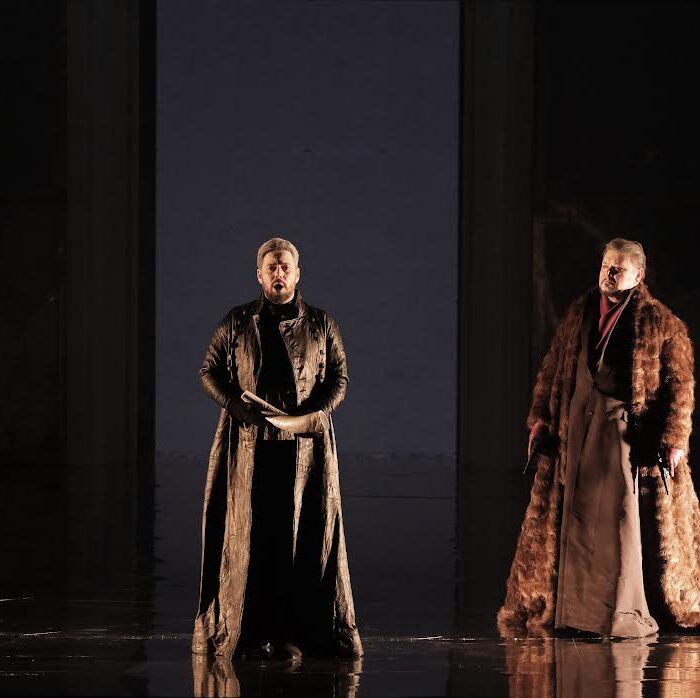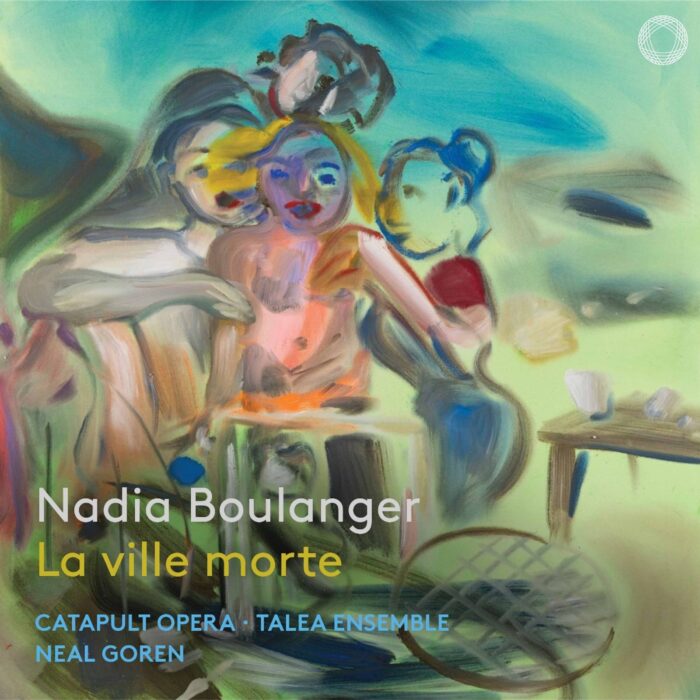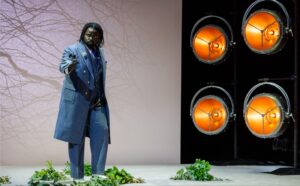
Boston Lyric Opera 2024 Review: Mitridate
By João Marcos Copertino(Photo credit: Nile Scott Studios)
What can one expect from an opera that the one and only Wolfgang Amadeus Mozart composed when he was a mere fourteen years young? It is impressive considering the age of its composer and disappointing if we bear in mind what came next—like listening to Wagner’s “Die Feen,” Verdi’s “I Due Foscari” or even Puccini’s “Edgar.” Boston Lyric Opera’s (BLO) production, however, tries its best to elevate Mozart’s juvenilia into a virtuoso showcase of acrobatic coloratura. Few times in Boston has opera been staged with so many stars—especially in a performance of obscure music.
Stellar Staging & Production
The rule of a good performance is simple: to make good music, invite good musicians; and, for good stagings, good directors. When it comes to that, BLO seems to be more and more aware of what needs to be done. One of the advantages of having good musicians is that, even though they might not be the most skilled method actors, they are artists, and as artists they compellingly commit to their craft. It pays off, especially under James Darrah’s nonsensical stage conception.
Actually there are more than a few things to enjoy about Darrah’s stage conception. Nobody really expects the most elevated drama from Mozart’s early works, and indeed “Mitridate’s” plot might be a bit too much if taken seriously. Darrah wisely makes the opera truly comedic, as if it were a mockery of a certain kind of politics common in the theater of Jean Racine and Pierre Corneille. No character is allowed even an inch of interiority—all their emotions are there, so absurdly presented as to seem pathetic. Facing this, the performers nevertheless all committed to their emotional experience, and to their own shallowness—making the drama actually more watchable than if the opera were seriously staged. Believe me, nothing is more torturous than a “Mitridate” or “Lucio Silla” staging that takes itself too seriously.
The performance began with the premise of a certain rigidity of movement, and it was interesting to follow the ways that the acting—and even the singing—explored precisely the consequences of that premise. No actor was meant to move or behave naturally, as if they were almost dolls. Their costumes seemed to have come from a gift store in Disney World (perhaps they did), conveying a sense of artificiality that made Mozart’s music clever during the first two acts, and extremely dramatic in the final scenes.
I would not mind scenarios more rooted in aestheticism. The white walls with some (well-crafted) video projections were on the border between the tedious and the clumsy—but the body work of the actors was there, and that is, to my mind, what matters the most.
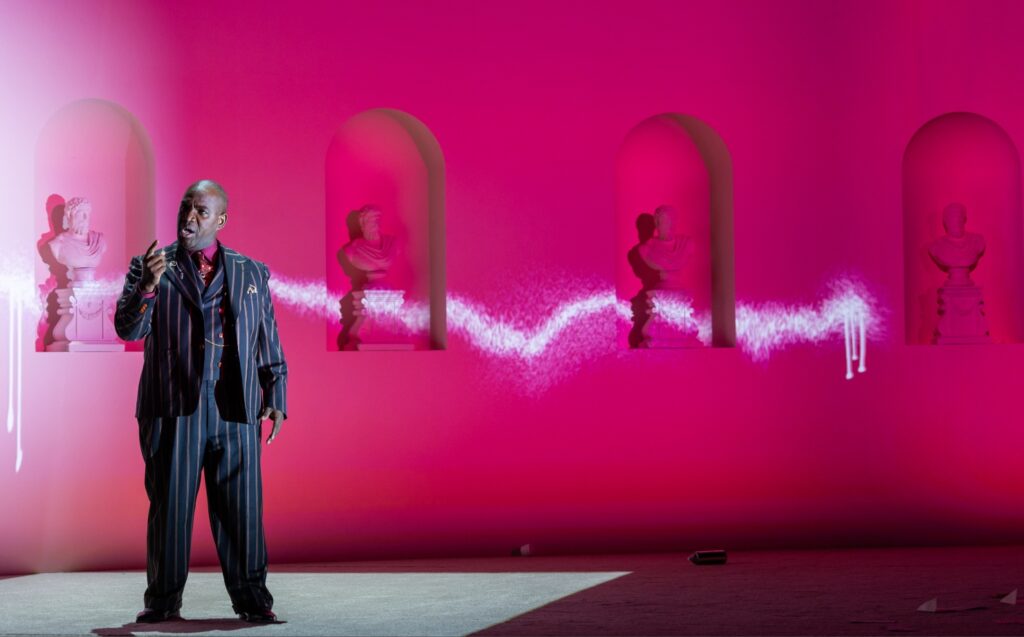
Illuminating Cast
David Angus conducted the cast with his usual effectiveness. Given BLO’s resources, I am always impressed by Angus’s work in the pit. The orchestra is always well-balanced, never covering the singers, never distracting one from the music. Angus knew that the center of the action relies on the vocal action and on Mozart’s instrumental use of the human voice.
The cast was captained by Lawrence Brownlee. Undeniably one the greatest tenors of his generation, he impressed me the most with his great command of Italian, fully linked to a titanic phrasing. He sang his vocal lines in a straight manner, as if he were composing a rectangular figure with his voice. It is hard to convey how impressive such a solution was for the characterization of Mitridate—suffice it to say that it worked. Also, given the precision and beauty of Brownlee’s coloratura, I only wished that Mozart had added more ornaments so Brownlee could delight us further.
Another impressive portrait was John Holiday’s Farnace. Despite Holiday’s success in mass media, especially his participation on “The Voice”, his achievements in live performances of opera are way greater. His voice is truly a gift, especially with its vibrant and piercing top register. It is hard to have much sympathy for Farnace as a character—actually it is hard to enjoy any role in “Mitridate”, but Holiday is a virtuoso on his own.
Challenging Lowlights
I will not lie; I often have a hard time enjoying Brenda Rae’s performances. I find her scenic commitment laudable, and I am aware of the scarcity of sopranos who can deal with such demanding repertoire; however, her voice often rings too soft against an orchestra, her pitch is a bit too shabby and—most importantly—her musical phrasing often seems too segmented, as if she were singing an aria focusing on individual phrases rather than on a bigger musical arch. Her Aspasia was not much different. She was the great actress and committed scenic performer that she always is; but she was also the singer that I struggle to enjoy. It might be an individual matter—I am perfectly aware that Rae is booked by the fanciest houses in the world. Most of the time, her Italian seemed to be questionable in its pronunciation and a bit aloof from the meaning of the words—something that is not uncommon for higher voices. Interestingly enough, it was in Aspasia’s “Ah ben ne fui presaga…Pallid’ ombre” in the final act of the opera that, for the first time, I could enjoy Rae’s vocal artistry—with an piano orchestra, and her main task to sustain long notes in the middle register, it was truly pleasurable.
Another issue was the casting of Vanessa Goikoetxea as Sifare. The soprano has great musical instincts—especially in regards to phrasing. She is capable of many subtleties, and she understands the aria in a major sense; she recites the first verse knowing very well how she wants you to hear it, and all the verses that follow. However, her voice has a darker and heavier tone that seems unfit for trouser roles, especially a role that is meant to be the child of Mitridate. It was as if Tosca decided to be Cherubino.
Perhaps aware of this particular characteristic of Goikoetxea’s instrument, Darrah staged the opera as if Sifare were a woman in a lesbian relationship with Aspasia. The result was, to my eyes, compromising and a weird outcome of certain misunderstandings of queerness. For queer theorists, queer art is less about positive representations (as it was for GLAAD) and more about understanding how the logics of closeting, shame, and persecution affect the self, and about how such logics can insinuate themselves into the most intimate grounds of one’s desire—something over which one has no control. However, commercialized images are more concerned with positively representing queer figures than with understanding what an experience of queerness might entail for anyone who actually lives it. There is a reason for that: the visual and explicit is much more commercially tamable than the queer person who struggles and suffers to come with terms with themselves and their relation to art.
Thus, by following the current trend of replacing trouser roles with explicit lesbian representation, even when guided by the laudable desire to avoid “transfakism,” stage directors erase much of what is queer about baroque opera, transforming it into hyper-evident and digestible versions of unoriginal, and only nominally queer, relationships. The result is particularly hysterical in Boston. Boston’s opera public is, in many ways, very warm and politically left-leaning—which often allows the BLO to bring forward bold staging concepts to their staging of operas, even with lesser funds than bigger companies (for instance, their Californian take on Puccini’s “Madama Butterfly”). In a certain way, Bostonians allow BLO to have more consequential stagings than are possible for most of America. Nonetheless, it means that there are some gestures that a Bostonian operatic audience cannot resist. So, when Darrah staged a lesbian kiss between Aspasia and Sifare, the audience went nuts—the very walls of the theater started to applaud. Not even a Brazilian carnival is that loud.
However, what has happened to the closeting element that makes trouser roles so appealing, the closeting that queer theorist Terry Castle found so compelling when she wrote about Brigitte Fassbaender, or that has inspired the lyricism criticism of Wayne Koestenbaum? It was all gone. Moreover, had they paid more attention to the execution of the scene, and not to the gesture itself—i.e. the kiss—, the audience would have seen that Rae and Goikoetxea had no chemistry at all (which was more Goikoetxea’s fault than Rae’s, I must admit), and that their voices failed to blend in “Se viver non deggio.” It was hard to say they shared the same sense of tuning. It was certainly the lowest point of the night.
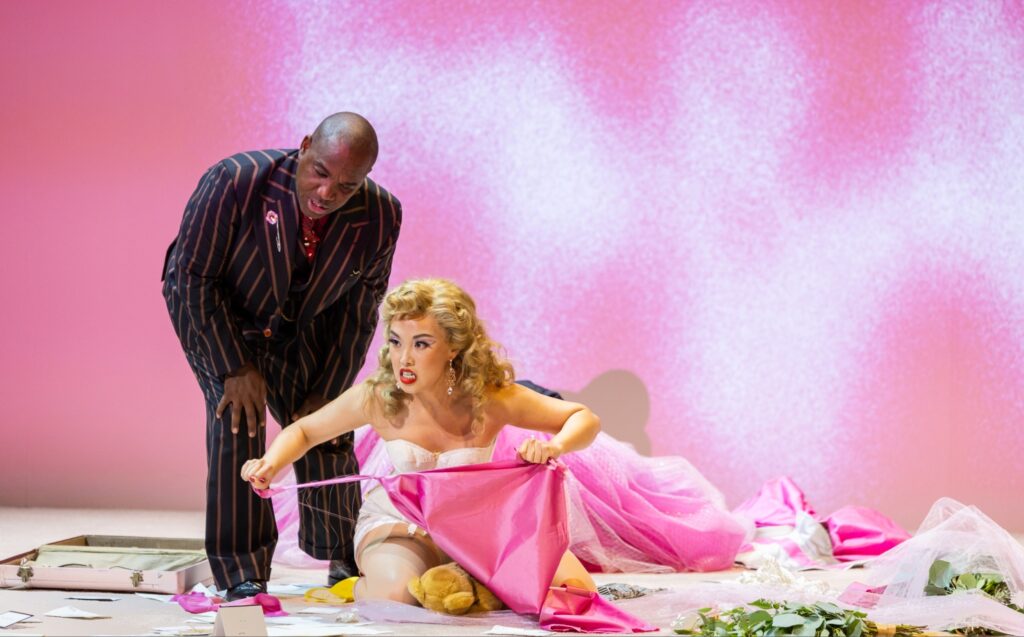
More Highlights
On the bright side, Angela Yam stole the show with her scenic charm. She performed Ismene with a level of aloofness and ridiculousness that only great actors can deploy—extremely rigidly composed, and with the inflexibility of a 1980s Barbie doll: it was hard not to laugh at her impeccable understanding of comedy. She is clearly an actress to watch. Vocally, too, she is very good. With a solid voice, and a very good command of the textual language, she might be one of those sopranos who shine in their acting, but her voice works scenically very well, and with much flexibility. I could imagine her singing repertoire ranging from early baroque to contemporary music.
The cast was complemented by the solid performances of a maternal Alexis Paert as Arbate, and a perhaps not-so-agile Marzio in Charles Sy.
Overall, against all odds, Boston Lyric Opera’s season opener gives us much to enjoy: a world-class cast, a good orchestral performance, an austere but not entirely unimaginative staging, and most importantly, some musical vigor—something much needed in the Boston Operatic scene.

